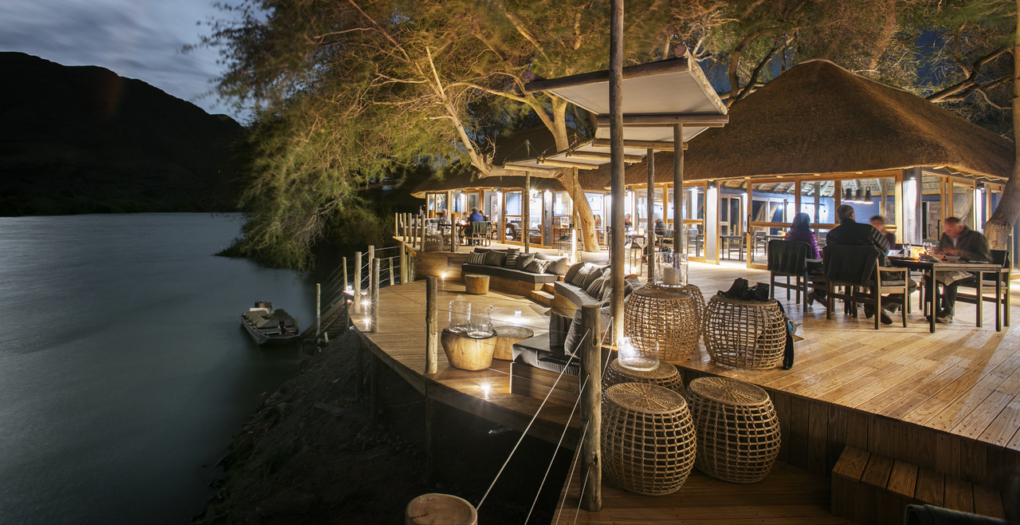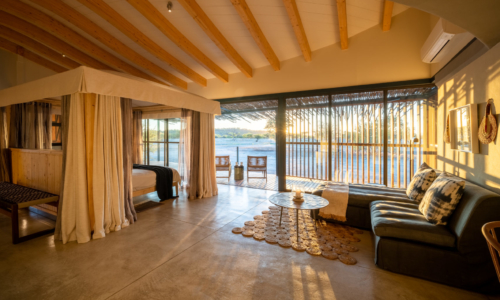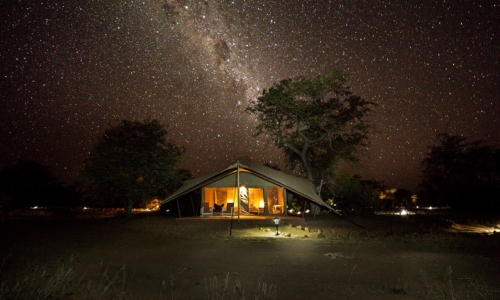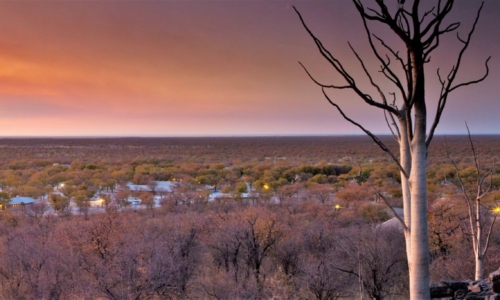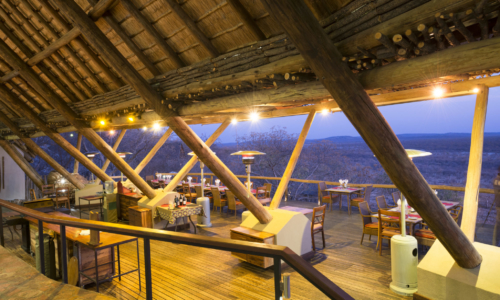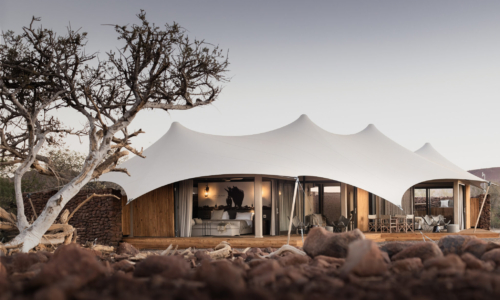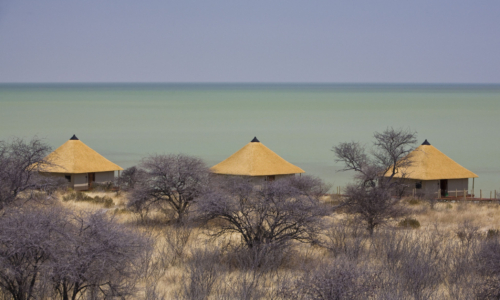The eight Meru-style resident tents made from wood, canvas and thatch are the perfect haven of comfort after long hot days exploring the surrounding terrain. Seven of the tents come with two twin beds that can be combined to make a double. In addition to which, the camp has one family unit that can sleep up to four people in two adjacent rooms connected by a door. The intimate and luxurious honeymoon chalet must be booked well in advance due to its popularity. Each tent has an en-suite bathroom, ceiling fan and mosquito nets. The tents are built on large, elevated decks for picturesque views over the Kunene River.
The camp is nestled in the shade of the Albia trees right on the banks of the Kunene river in Hartmann’s Valley. As the only permanent water source in the region, the Kunene River and its verdant banks cut a winding band of green through the lunar-like landscape of the Namib Desert which stretches to the Serra Cafema mountain range in the north. There are small herds of gemsbok, springbok, and Hartmann’s mountain zebra in the area. The Kunene River even has a large population of Nile crocodiles. For bird lovers, Burchell’s courser and Benguela long-billed lark are some of the bird species to be found here.
Activities at Serra Cafema center on exploring the contrasting topography. Within the same day, one can cruise on the river observing the behavior of crocodiles and then traverse the sand dunes on a guided quad bike excursion. Informative nature drives in open Land Rovers explore the vast dunes of the Namib Desert. For a closer look, there are also nature walks with a knowledgeable guide. For a cultural tour, a visit to the local Himba settlement is also a must, as the Himba are one of the last truly nomadic peoples in Africa.
The main area of camp known as the Ozonganda comprises both an indoor and outdoor dining area, a sunken lounge, a library, and a curio shop that all have their own spectacular views of the desert and river. The camp’s refreshing swimming pool is the place to be during the heat of the day. For some added relaxation, massage treatments are available. An eco-friendly property, the camp uses solar power to reduce its impact on the environment.

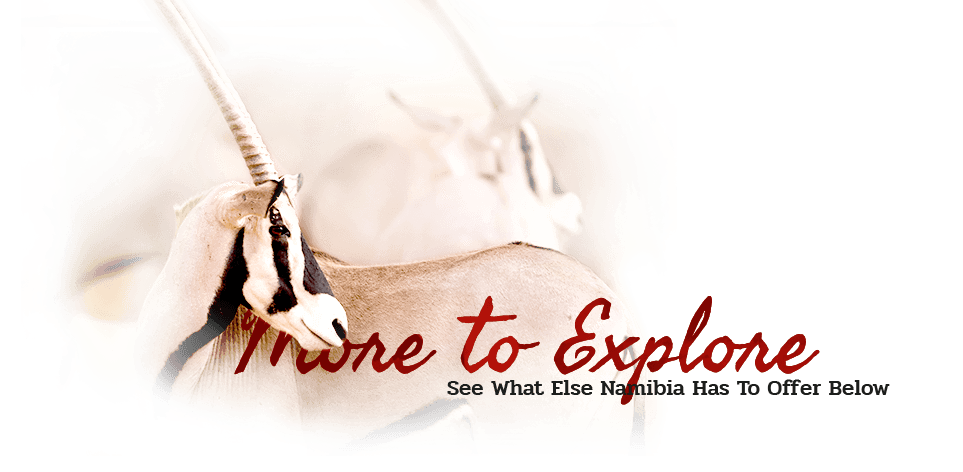
- Anderssons at Ongava
- Babson House
- Camp Kipwe
- Canyon Lodge
- Canyon Roadhouse
- Canyon Village
- Cape Cross Lodge
- Chobe Savanna Lodge
- Damara Mopane Lodge
- Damaraland Camp
- Dead Valley Lodge
- Desert Hills Glamping Camp
- Desert Homestead
- Desert Homestead Outpost
- Desert Rhino Camp
- Dolomite Camp
- Doro Nawas Camp
- Eagle’s Nest Lodge
- Erongo Wilderness Lodge
- Etosha Heights Safari House
- Etosha Mountain Lodge
- Etosha Safari Camp
- Etosha Safari Lodge
- Fish River Lodge
- Fort Sesfontein Lodge
- Grootberg Lodge
- Halali Camp
- Hoanib Elephant Camp
- Hoanib Skeleton Coast Camp
- Hoanib Valley Camp
- Ichingo Chobe River Lodge
- Kalahari Anib Lodge
- Kalahari Farmhouse
- Khorixas Rest Camp
- Kulala Desert Lodge
- Kwessi Dunes
- Little Kulala
- Little Ongava
- Malansrus Tented Camp
- Mowani Mountain Camp
- Mushara Bush Camp
- Mushara Lodge
- Mushara Outpost
- Naankuse Lodge
- Namib Desert Lodge
- Namushasha River Lodge
- Namutoni Camp
- Nhoma Safari Camp
- Nkasa Linyanti
- Okahirongo Elephant Lodge
- Okahirongo River Camp
- Okaukuejo Camp
- Okonjima Bush Camp
- Okonjima Bush Suite
- Okonjima Grand African Villa
- Okonjima Plains Camp
- Onduli Ridge
- Ongava Lodge
- Ongava Tented Camp
- Onguma Bush Camp
- Onguma Etosha Aoba Lodge
- Onguma Tented Camp
- Onguma The Fort
- Onguma Tree Top Camp
- Onkoshi Camp
- Ozondjou Trails
- Popa Falls Camp
- River Crossing Lodge
- Safarihoek Lodge
- Serra Cafema Camp
- Shipwreck Lodge
- Sossus Dune Lodge
- Sossusvlei Desert Lodge
- Terrace Bay Camp
- Teufelskrallen Tented Lodge
- Villa Mushara
- Wolwedans Boulders Safari Camp
- Wolwedans Dune Camp
- Wolwedans Dunes Lodge
- Wolwedans Mountain View Suite
- Wolwedans Private Camp
- Anderssons at Ongava
- Babson House
- Camp Kipwe
- Canyon Lodge
- Canyon Roadhouse
- Canyon Village
- Cape Cross Lodge
- Chobe Savanna Lodge
- Damara Mopane Lodge
- Damaraland Camp
- Dead Valley Lodge
- Desert Hills Glamping Camp
- Desert Homestead
- Desert Homestead Outpost
- Desert Rhino Camp
- Dolomite Camp
- Doro Nawas Camp
- Eagle’s Nest Lodge
- Erongo Wilderness Lodge
- Etosha Heights Safari House
- Etosha Mountain Lodge
- Etosha Safari Camp
- Etosha Safari Lodge
- Fish River Lodge
- Fort Sesfontein Lodge
- Grootberg Lodge
- Halali Camp
- Hoanib Elephant Camp
- Hoanib Skeleton Coast Camp
- Hoanib Valley Camp
- Ichingo Chobe River Lodge
- Kalahari Anib Lodge
- Kalahari Farmhouse
- Khorixas Rest Camp
- Kulala Desert Lodge
- Kwessi Dunes
- Little Kulala
- Little Ongava
- Malansrus Tented Camp
- Mowani Mountain Camp
- Mushara Bush Camp
- Mushara Lodge
- Mushara Outpost
- Naankuse Lodge
- Namib Desert Lodge
- Namushasha River Lodge
- Namutoni Camp
- Nhoma Safari Camp
- Nkasa Linyanti
- Okahirongo Elephant Lodge
- Okahirongo River Camp
- Okaukuejo Camp
- Okonjima Bush Camp
- Okonjima Bush Suite
- Okonjima Grand African Villa
- Okonjima Plains Camp
- Onduli Ridge
- Ongava Lodge
- Ongava Tented Camp
- Onguma Bush Camp
- Onguma Etosha Aoba Lodge
- Onguma Tented Camp
- Onguma The Fort
- Onguma Tree Top Camp
- Onkoshi Camp
- Ozondjou Trails
- Popa Falls Camp
- River Crossing Lodge
- Safarihoek Lodge
- Serra Cafema Camp
- Shipwreck Lodge
- Sossus Dune Lodge
- Sossusvlei Desert Lodge
- Terrace Bay Camp
- Teufelskrallen Tented Lodge
- Villa Mushara
- Wolwedans Boulders Safari Camp
- Wolwedans Dune Camp
- Wolwedans Dunes Lodge
- Wolwedans Mountain View Suite
- Wolwedans Private Camp

The eight Meru-style resident tents made from wood, canvas and thatch are the perfect haven of comfort after long hot days exploring the surrounding terrain. Seven of the tents come with two twin beds that can be combined to make a double. In addition to which, the camp has one family unit that can sleep up to four people in two adjacent rooms connected by a door. The intimate and luxurious honeymoon chalet must be booked well in advance due to its popularity. Each tent has an en-suite bathroom, ceiling fan and mosquito nets. The tents are built on large, elevated decks for picturesque views over the Kunene River.
The camp is nestled in the shade of the Albia trees right on the banks of the Kunene river in Hartmann’s Valley. As the only permanent water source in the region, the Kunene River and its verdant banks cut a winding band of green through the lunar-like landscape of the Namib Desert which stretches to the Serra Cafema mountain range in the north. There are small herds of gemsbok, springbok, and Hartmann’s mountain zebra in the area. The Kunene River even has a large population of Nile crocodiles. For bird lovers, Burchell’s courser and Benguela long-billed lark are some of the bird species to be found here.
Activities at Serra Cafema center on exploring the contrasting topography. Within the same day, one can cruise on the river observing the behavior of crocodiles and then traverse the sand dunes on a guided quad bike excursion. Informative nature drives in open Land Rovers explore the vast dunes of the Namib Desert. For a closer look, there are also nature walks with a knowledgeable guide. For a cultural tour, a visit to the local Himba settlement is also a must, as the Himba are one of the last truly nomadic peoples in Africa.
The main area of camp known as the Ozonganda comprises both an indoor and outdoor dining area, a sunken lounge, a library, and a curio shop that all have their own spectacular views of the desert and river. The camp’s refreshing swimming pool is the place to be during the heat of the day. For some added relaxation, massage treatments are available. An eco-friendly property, the camp uses solar power to reduce its impact on the environment.

- Anderssons at Ongava
- Babson House
- Camp Kipwe
- Canyon Lodge
- Canyon Roadhouse
- Canyon Village
- Cape Cross Lodge
- Chobe Savanna Lodge
- Damara Mopane Lodge
- Damaraland Camp
- Dead Valley Lodge
- Desert Hills Glamping Camp
- Desert Homestead
- Desert Homestead Outpost
- Desert Rhino Camp
- Dolomite Camp
- Doro Nawas Camp
- Eagle’s Nest Lodge
- Erongo Wilderness Lodge
- Etosha Heights Safari House
- Etosha Mountain Lodge
- Etosha Safari Camp
- Etosha Safari Lodge
- Fish River Lodge
- Fort Sesfontein Lodge
- Grootberg Lodge
- Halali Camp
- Hoanib Elephant Camp
- Hoanib Skeleton Coast Camp
- Hoanib Valley Camp
- Ichingo Chobe River Lodge
- Kalahari Anib Lodge
- Kalahari Farmhouse
- Khorixas Rest Camp
- Kulala Desert Lodge
- Kwessi Dunes
- Little Kulala
- Little Ongava
- Malansrus Tented Camp
- Mowani Mountain Camp
- Mushara Bush Camp
- Mushara Lodge
- Mushara Outpost
- Naankuse Lodge
- Namib Desert Lodge
- Namushasha River Lodge
- Namutoni Camp
- Nhoma Safari Camp
- Nkasa Linyanti
- Okahirongo Elephant Lodge
- Okahirongo River Camp
- Okaukuejo Camp
- Okonjima Bush Camp
- Okonjima Bush Suite
- Okonjima Grand African Villa
- Okonjima Plains Camp
- Onduli Ridge
- Ongava Lodge
- Ongava Tented Camp
- Onguma Bush Camp
- Onguma Etosha Aoba Lodge
- Onguma Tented Camp
- Onguma The Fort
- Onguma Tree Top Camp
- Onkoshi Camp
- Ozondjou Trails
- Popa Falls Camp
- River Crossing Lodge
- Safarihoek Lodge
- Serra Cafema Camp
- Shipwreck Lodge
- Sossus Dune Lodge
- Sossusvlei Desert Lodge
- Terrace Bay Camp
- Teufelskrallen Tented Lodge
- Villa Mushara
- Wolwedans Boulders Safari Camp
- Wolwedans Dune Camp
- Wolwedans Dunes Lodge
- Wolwedans Mountain View Suite
- Wolwedans Private Camp
- Anderssons at Ongava
- Babson House
- Camp Kipwe
- Canyon Lodge
- Canyon Roadhouse
- Canyon Village
- Cape Cross Lodge
- Chobe Savanna Lodge
- Damara Mopane Lodge
- Damaraland Camp
- Dead Valley Lodge
- Desert Hills Glamping Camp
- Desert Homestead
- Desert Homestead Outpost
- Desert Rhino Camp
- Dolomite Camp
- Doro Nawas Camp
- Eagle’s Nest Lodge
- Erongo Wilderness Lodge
- Etosha Heights Safari House
- Etosha Mountain Lodge
- Etosha Safari Camp
- Etosha Safari Lodge
- Fish River Lodge
- Fort Sesfontein Lodge
- Grootberg Lodge
- Halali Camp
- Hoanib Elephant Camp
- Hoanib Skeleton Coast Camp
- Hoanib Valley Camp
- Ichingo Chobe River Lodge
- Kalahari Anib Lodge
- Kalahari Farmhouse
- Khorixas Rest Camp
- Kulala Desert Lodge
- Kwessi Dunes
- Little Kulala
- Little Ongava
- Malansrus Tented Camp
- Mowani Mountain Camp
- Mushara Bush Camp
- Mushara Lodge
- Mushara Outpost
- Naankuse Lodge
- Namib Desert Lodge
- Namushasha River Lodge
- Namutoni Camp
- Nhoma Safari Camp
- Nkasa Linyanti
- Okahirongo Elephant Lodge
- Okahirongo River Camp
- Okaukuejo Camp
- Okonjima Bush Camp
- Okonjima Bush Suite
- Okonjima Grand African Villa
- Okonjima Plains Camp
- Onduli Ridge
- Ongava Lodge
- Ongava Tented Camp
- Onguma Bush Camp
- Onguma Etosha Aoba Lodge
- Onguma Tented Camp
- Onguma The Fort
- Onguma Tree Top Camp
- Onkoshi Camp
- Ozondjou Trails
- Popa Falls Camp
- River Crossing Lodge
- Safarihoek Lodge
- Serra Cafema Camp
- Shipwreck Lodge
- Sossus Dune Lodge
- Sossusvlei Desert Lodge
- Terrace Bay Camp
- Teufelskrallen Tented Lodge
- Villa Mushara
- Wolwedans Boulders Safari Camp
- Wolwedans Dune Camp
- Wolwedans Dunes Lodge
- Wolwedans Mountain View Suite
- Wolwedans Private Camp

















